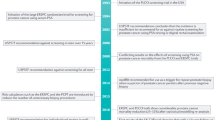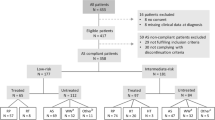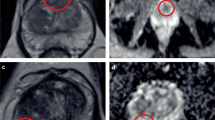Abstract
This review summarizes the case for active surveillance of 'good-risk' prostate cancer, with selective delayed intervention for rapid biochemical progression, assessed by rising prostate-specific antigen (PSA) levels or grade progression. The results of a large phase II trial using this approach are also reviewed. A prospective phase II study of active surveillance with selective delayed intervention was initiated in 1995. Patients were managed initially with surveillance; those who had a PSA doubling time (PSADT) of ≤2 years, or grade progression on repeat biopsy, were offered radical intervention. The remaining patients were closely monitored. The cohort now consists of 299 patients with good-risk—or, in men over 70 years of age, intermediate-risk—prostate cancer. The median PSADT was 7 years, 42% had a PSADT >10 years. The majority of patients remain on surveillance. At 8 years, overall actuarial survival was 85%, and disease-specific survival was 99%.To date, this study has shown that most men with 'good-risk' prostate cancer will die of unrelated causes. The approach of active surveillance with selective delayed intervention based on PSADT represents a practical compromise between radical therapy for all patients, which results in overtreatment for patients with indolent disease, and watchful waiting with palliative therapy only, which results in undertreatment for those with aggressive disease. The results at 8 years were favorable. Longer follow-up will be required if the study is to confirm the safety of this approach in men with a long life expectancy (>15 years).
This is a preview of subscription content, access via your institution
Access options
Subscribe to this journal
Receive 12 print issues and online access
$189.00 per year
only $15.75 per issue
Buy this article
- Purchase on SpringerLink
- Instant access to full article PDF
Prices may be subject to local taxes which are calculated during checkout
Similar content being viewed by others
References
Sakr WA et al. (1993) The frequency of carcinoma and intraepithelial neoplasia of the prostate in young male patients. J Urol 150: 379–385
Stamey TA et al. (1993) Localized prostate cancer. Relationship of tumor volume to clinical significance for treatment of prostate cancer. Cancer 71 (Suppl 3): S933–S938
Boring CC et al. (1993) Cancer statistics, 1993. CA Cancer J Clin 43: 7–26
Jemal A et al. (2004) Cancer Statistics, 2004. CA Cancer J Clin 54: 8–29
Thompson IM et al. (2003) The influence of finasteride on the development of prostate cancer. N Engl J Med 349: 215–224
McGregor M et al. (1998) Screening for prostate cancer: estimating the magnitude of overdetection. CMAJ 159: 1368–1372
Etzioni R et al. (2002) Overdiagnosis due to prostate-specific antigen screening: lessons from U.S. prostate cancer incidence trends. J Natl Cancer Inst 94: 981–990
Singh H et al. (2004) Improved detection of clinically significant, curable prostate cancer with systematic 12-core biopsy. J Urol 171: 1089–1092
Presti JC Jr (2003) Prostate biopsy: how many cores are enough? Urol Oncol 21: 135–140
Sakr WA et al. (1996) Age and racial distribution of prostatic intraepithelial neoplasia. Eur Urol 30: 138–144
Pound C et al. (1999) Natural history of progression after PSA elevation following radical prostatectomy. JAMA 281: 1591–1597
Cooperberg MR et al. (2003) Time trends in clinical risk stratification for prostate cancer: implications for outcomes (data from CaPSURE). J Urol 170 (Suppl): S21–S25
Albertsen P et al. (1998) Competing risk analysis of men aged 55 to 74 years at diagnosis managed conservatively for clinically localized prostate cancer. JAMA 280: 975–980
Chodak G (1994) The role of watchful waiting in the management of localized prostate cancer. J Urol 152: 1766–1768
D'Amico AV et al. (2004) Preoperative PSA velocity and the risk of death from prostate cancer after radical prostatectomy. N Engl J Med 351: 125–135
Aus G et al. (1995) Long-term survival and mortality in prostate cancer treated with noncurative intent. J Urol 154: 460–465
Johansson JE et al. (2004) Natural history of early, localized prostate cancer. JAMA 291: 2713–2719
Parker C (2004) Active surveillance: towards a new paradigm in the management of early prostate cancer. Lancet Oncol 5: 101–106
Parker C (2003) Active surveillance: an individualized approach to early prostate cancer. BJU Int 92: 2–3
Choo R et al. (2002) Feasibility study: watchful waiting for localized low to intermediate grade prostate carcinoma with selective delayed intervention based on prostate specific antigen, histological and/or clinical progression. J Urol 167: 1664–1669
Choo R et al. (2001) PSA doubling time of prostate carcinoma managed with watchful observation alone. Int J Radiat Oncol Biol Phys 50: 615–620
Epstein JI et al. (2001) Dedifferentiation of prostate cancer grade with time in men followed expectantly for stage T1c disease. J Urol 166: 1688–1691
Epstein JI et al. (1994) Pathologic and clinical findings to predict tumor extent of nonpalpable (stage T1c) prostate cancer. JAMA 271: 368–374
Epstein JI et al. (1993) Correlation of pathologic findings with progression after radical retropubic prostatectomy. Cancer 71: 3582–3593
Epstein JI et al. (1993) Is tumor volume an independent predictor of progression following radical prostatectomy? A multivariate analysis of 185 clinical stage B adenocarcinomas of the prostate with 5 years of followup. J Urol 149: 1478–1481
Epstein JI et al. (1998) Nonpalpable stage T1c prostate cancer: prediction of insignificant disease using free/total prostate specific antigen levels and needle biopsy findings. J Urol 160: 2407–2411
Goto Y et al. (1996) Distinguishing clinically important from unimportant prostate cancers before treatment: value of systematic biopsies. J Urol 156: 1059–1063
Kattan MW et al. (2003) Counseling men with prostate cancer: a nomogram for predicting the presence of small, moderately differentiated, confined tumors. J Urol 170: 1792–1797
Augustin H et al. (2003) Insignificant prostate cancer in radical prostatectomy specimen: time trends and preoperative prediction. Eur Urol 43: 455–460
Noguchi M et al. (2001) Relationship between systematic biopsies and histological features of 222 radical prostatectomy specimens: lack of prediction of tumor significance for men with nonpalpable prostate cancer. J Urol 166: 104–109
Stamey TA et al. (2004) The prostate specific antigen era in the United States is over for prostate cancer: what happened in the last 20 years? J Urol 172: 1297–1301
Schmid HP et al. (1993) Observations on the doubling time of prostate cancer. The use of serial prostate-specific antigen in patients with untreated disease as a measure of increasing cancer volume. Cancer 71: 2031–2040
Hanks GE et al. (1996) Pretreatment prostate-specific antigen doubling times: clinical utility of this predictor of prostate cancer behavior. Int J Radiat Oncol Biol Phys 34: 549–553
D'Amico AV et al. (2003) Surrogate end point for prostate cancer-specific mortality after radical prostatectomy or radiation therapy. J Natl Cancer Inst 95: 1376–1383
McLaren DB et al. (1998) Watchful waiting or watchful progression?: Prostate specific antigen doubling times and clinical behavior in patients with early untreated prostate carcinoma. Cancer 82: 342–348
Egawa S et al. (2000) Use of pretreatment prostate-specific antigen doubling time to predict outcome after radical prostatectomy. Prostate Cancer Prostatic Dis 3: 269–274
Berges RR et al. (1995) Implication of cell kinetic changes during the progression of human prostatic cancer. Clin Cancer Res 1: 473–480
Egawa S et al. (1999) Observations of prostate specific antigen doubling time in Japanese patients with nonmetastatic prostate carcinoma. Cancer 86: 463–469
Bangma CH (1995) Serial prostate specific antigen measurements and progression in untreated confined (stages T0 to 3NxM0, grades 1 to 3) carcinoma of the prostate. J Urol 154: 1403–1406
Gerber GS et al. (1998) Evaluation of changes in prostate specific antigen in clinically localized prostate cancer managed without initial therapy. J Urol 159: 1243–1246
Vollmer RT et al. (2002) The dynamics of prostate specific antigen during watchful waiting of prostate carcinoma: a study of 94 Japanese men. Cancer 94: 1692–1698
Do V et al. (2002) The role of serial free/total prostate-specific antigen ratios in a watchful observation protocol for men with localized prostate cancer. BJU Int 89: 703–709
Steineck G et al. (2002) Quality of life after radical prostatectomy or watchful waiting. N Engl J Med 347: 790–796
Hanash K et al. (1972) Carcinoma of the prostate: a 15-year followup. J Urol 107: 450–453
Lerner S et al. (1991) The risk of dying of prostate cancer in patients with clinically localized disease. J Urol 146: 1040–1045
Schmid HP et al. (2001) Active monitoring (deferred treatment or watchful waiting) in the treatment of prostate cancer. A review. Eur Urol 40: 488–494
Handley R et al. (1988) Deferred treatment for prostate cancer. Br J Urol 62: 249–253
Waaler G and Stenwig AE (1993) Prognosis of localised prostatic cancer managed by “watch and wait” policy. Br J Urol 72: 214–219
Whitmore W et al. (1991) Expectant management of localized prostatic cancer. Cancer 67: 1091–1096
George NJ (1988) Natural history of localised prostatic cancer managed by conservative therapy alone. Lancet 1: 494–497
Holmberg L et al. (2002) A randomized trial comparing radical prostatectomy with watchful waiting in early prostate cancer. N Engl J Med 347: 781–789
Foley J and Thompson I (2000) Natural history of localized adenocarcinoma of prostate. In Advanced therapy of prostate disease, 87–91 (Eds Resnick M and Thompson I) London: BC Decker, Inc
Author information
Authors and Affiliations
Corresponding author
Ethics declarations
Competing interests
The author declares no competing financial interests.
Glossary
- PSA DOUBLING TIME (PSADT)
-
The time taken for the detected PSA level to double. This test is used as an indicator of the rate of disease progression in patients with prostate cancer
- PERCENTAGE FREE PSA (%fPSA)
-
The percentage of PSA in the blood that is found unbound to proteins. Prostate cancer is associated with a lower percent free serum PSA than benign prostate tissue
Rights and permissions
About this article
Cite this article
Klotz, L. Active surveillance with selective delayed intervention is the way to manage 'good-risk' prostate cancer. Nat Rev Urol 2, 136–142 (2005). https://doi.org/10.1038/ncpuro0124
Received:
Accepted:
Issue date:
DOI: https://doi.org/10.1038/ncpuro0124
This article is cited by
-
Evolution of multi-parametric MRI quantitative parameters following transrectal ultrasound-guided biopsy of the prostate
Prostate Cancer and Prostatic Diseases (2015)
-
Prostate cancer survivorship: lifestyle changes, much needed!
World Journal of Urology (2015)
-
Serum micronutrient and antioxidant levels at baseline and the natural history of men with localised prostate cancer on active surveillance
Tumor Biology (2010)
-
Editorial and introduction to Asian Journal of Andrology Prostate Cancer special issue
Asian Journal of Andrology (2009)
-
Photodynamic therapy for prostate cancer—a review of current status and future promise
Nature Clinical Practice Urology (2009)



